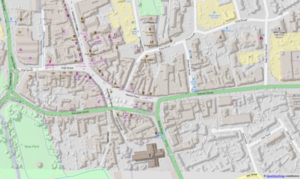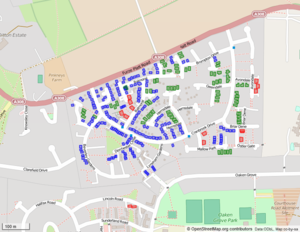LiDAR sources for the United Kingdom
Aerial LIDAR provides height data for terrain and objects such as buildings, and is available for use in OSM for much of the United Kingdom. This page collates details of the sources for the UK and various uses to which they have been put.
The data typically includes both digital terrain (DTM) and digital surface (DSM) models. This directly provides elevation of the terrain from which contour lines can be computed with a range of open source software (e.g., GDAL and QGIS). In addition the heights of features such as buildings, trees and hedges can be computed from the difference between the two models. Outlines or heights of such features might be derived from the LIDAR data in order to be input as vectors into OpenStreetMap.
DSM is the scan of the surface features from the aircraft including buildings, hedges, trees and even cars. The DTM data are processed version of DSM to remove the objects on the land, such as buildings etc, to reveal the underlying terrain.
Data is generally well-aligned so does not need realignment and can be used for aligning other aerial imagery. The LIDAR process means that this data does not suffer from parallax artefacts which often make aerial imagery difficult to interpret. Some 'clutter' is present however, largely as obvious artefacts over water.
England
The Environment Agency LIDAR data was first released in 2015 as an open data set under the Open government Licence (OGL).
Data are available at resolutions ranging from 10 metres down to 1m. Almost all of England is covered by 1m or 2m resolution data, except for a hole around RAF Fylingdales. Previously, finer scale data (50cm, 25cm) was available, but this have been withdrawn; this data was much patchier and focussed on areas most at risk of flooding.
Data is not necessarily very recent. In many areas it may be at least 5 years old. Comparison with local knowledge, Bing images and OSM data can be used to provide a rough estimate of age.
Tiles are natively in the OSGB projection (EPSG:27700).
Dataset links
The following composite datasets are currently available as tile layers:
1m DTM 2022 (>95% coverage) https://environment.data.gov.uk/dataset/13787b9a-26a4-4775-8523-806d13af58fc https://environment.data.gov.uk/spatialdata/lidar-composite-digital-terrain-model-dtm-1m-2022/wms
1m DSM 2022 https://environment.data.gov.uk/dataset/9ba4d5ac-d596-445a-9056-dae3ddec0178 https://environment.data.gov.uk/spatialdata/lidar-composite-digital-surface-model-last-return-dsm-1m-2022/wms
1m First Return DSM 2022 https://environment.data.gov.uk/dataset/df4e3ec3-315e-48aa-aaaf-b5ae74d7b2bb https://environment.data.gov.uk/spatialdata/lidar-composite-digital-surface-model-first-return-dsm-1m-2022/wms
2m DTM 2022 (>95% coverage) https://environment.data.gov.uk/dataset/09ea3b37-df3a-4e8b-ac69-fb0842227b04 https://environment.data.gov.uk/spatialdata/lidar-composite-digital-terrain-model-dtm-2m-2022/wms
2m DSM 2022 https://environment.data.gov.uk/dataset/f083c5dc-504f-4428-9811-a1b2519fa279 https://environment.data.gov.uk/spatialdata/lidar-composite-digital-surface-model-last-return-dsm-2m-2022/wms
Some tiles are available via Flickr without any georeferencing https://www.flickr.com/photos/environmentagencyopensurveydata/albums
Wales
Natural Resource Wales have published data with approximately 70% coverage and plan to provide full coverage. Details of the dataset are provided here. DSM and DTM tiles at various resolutions are available via WMTS: http://lle.gov.wales/services/tiles/lidar/wmts or the data can be downloaded for further use: https://lle.gov.wales/GridProducts#data=LidarCompositeDataset
Scotland
Tile servers and data from 11 separate surveys are available under the OGL via the Scottish Remote Sensing Portal.
Composite DSM & DTM data is also available for download.
50cm https://environment.data.gov.uk/portalstg/home/item.html?id=3d6ccc40767040a38e405f45e6676ee7
Northern Ireland
Datasets for Northern Ireland are published under an Open Government Licence, although the Belfast City 2006 dataset requires confirmation from the copyright holder that they would be happy with the location of an attribution statement before it's used in OSM https://www.opendatani.gov.uk/dataset?tags=LIDAR (see this thread for further information https://lists.openstreetmap.org/pipermail/talk-gb/2022-August/029324.html).
Various experiments so far
- https://houseprices.io/lab/lidar/map - England-wide overview map tiles created by 'hanoz' who posted to hacker news
- Chillly blog - Lidar - Chris was taking an early look back in June
- Chillly blog - More Lidar Goodness - featuring GDAL commands
- Chillly blog - Extracting building heights from LIDAR
- http://relief.raggedred.net - Chilly's map
- Phil Endecote posted experiments in edge detection
- User:EdLoach/Tendring LIDAR - Notes by EdLoach
- http://www.loach.me.uk/Lidar/ - Map covering his area with OSM overlay
- big mailing list discussion September (more since)
- User:Firefishy has a full complete bulk mirror.
- User:Gregrs/lidar2tiles – BASH script using GDAL to create tiles showing surface features e.g. buildings plus tiles covering Canterbury
- https://enfarchsoc.org/opendata/ shows LIDAR tiles on an openstreetmap background.
Deriving data for OpenStreetMap
Some of the above linked experiments are potential starting points for a process of deriving data which could be input into OpenStreetMap. In particular we may be able to vectorise building outlines or (more simply) get the height of buildings suitable for height=* values.
Some data input tests so far:
Importing or manual importing may be possible on a larger scale, but would only be carried out after deriving a separate data file, and probing the quality of this first.
The DTM data can be very helpful for mapping cliffs and paths, particularly in wooded areas, or identifying courses of ditches or streams for ground verification.

